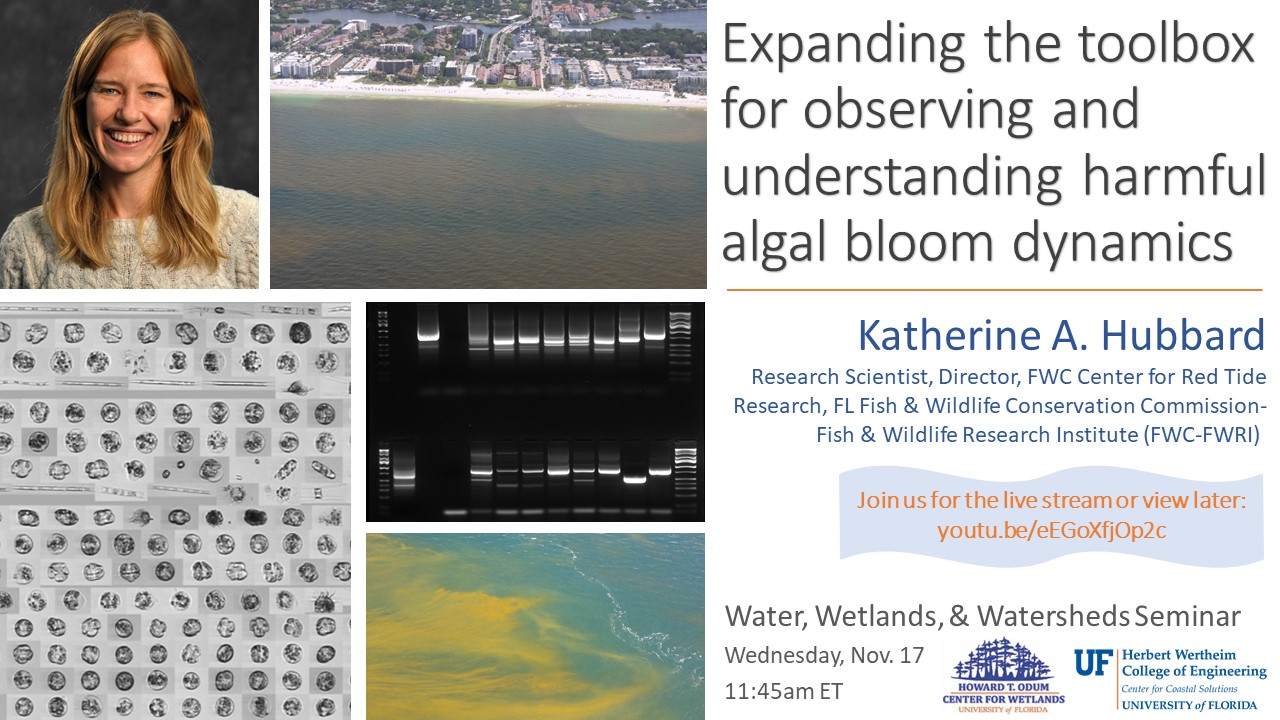November 17, 2021
Expanding the toolbox for observing and understanding harmful algal bloom dynamics
Katherine A. Hubbard, Research Scientist, Director, FWC Center for Red Tide Research, FL Fish and Wildlife Conservation Commission-Fish and Wildlife Research Institute (FWC-FWRI)
Join us for the live stream Nov 17, 11:45am EST: https://youtu.be/eEGoXfjOp2c
(Please visit our youtube channel main page for the stream if there are any issues with the direct link.)
ABSTRACT
Globally, harmful algal bloom (HAB) species cause a myriad of negative impacts by producing toxins that can be harmful to human and wildlife health, and/or by disrupting ecosystems. Emerging and persistent HAB issues present unique challenges to tracking and forecasting these events. Observation and monitoring networks for these HABs, their toxins, and associated impacts now routinely implement a diversity of tools that vary across HABs and regions. These tools help provide resource managers, health departments, and the public with timely information to inform decision-making. Specific examples will focus on the importance of key “tools” that can be developed and/or implemented as needed during marine HABs. Recognizing the ecological flexibility displayed by many HABs in lab and field studies, examples will be provided that demonstrate how expanding observational and modeling infrastructure is essential for understanding the response of HABs to environmental changes occurring across event to multi-decadal time scales, with a focus on sub-tropical to polar systems. Also critical to our success in building these comprehensive networks is the ability to communicate scientific results to broad audiences and to creatively span gaps among research, monitoring, and management communities.
Bio
Dr. Kate Hubbard leads the harmful algal bloom (HAB) monitoring and research program for the Florida Fish and Wildlife Conservation Commission’s Fish and Wildlife Research Institute (FWC-FWRI) and is the director of FWC’s Center for Red Tide Research. As a research scientist, she works closely with a broad network of partners to sustain and advance comprehensive HAB monitoring. Her expertise in genomics and ecology has also helped evaluate drivers of HABs and other species. Recent enhancements to Florida’s HAB monitoring network under her direction have focused on new, enhanced, and/or sustained biological, chemical, and physical observation capabilities. As a Co-Investigator of the NSF/NIEHS-funded Woods Hole Center for Oceans and Human Health at the Woods Hole Oceanographic Institution, Hubbard is involved in HAB detection and forecasting projects across the US to better understand and predict blooms and their impacts and is committed to working at the interface of HAB research and management. She also prioritizes engaging junior scientists in research and communication. She received her B.A. in Biology from New College of Florida and M.S. and Ph.D. degrees in Biological Oceanography from the University of Washington. She has served on the National HAB Committee since 2017.
POSTCARD

